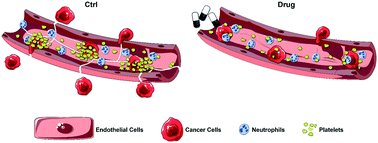A microphysiological early metastatic niche on a chip reveals how heterotypic cell interactions and inhibition of integrin subunit β3 impact breast cancer cell extravasation†
Abstract
During metastatic progression multiple players establish competitive mechanisms, whereby cancer cells (CCs) are exposed to both pro- and anti-metastatic stimuli. The early metastatic niche (EMN) is a transient microenvironment which forms in the circulation during CC dissemination. EMN is characterized by the crosstalk among CCs, platelets, leukocytes and endothelial cells (ECs), increasing CC ability to extravasate and colonize secondary tissues. To better understand this complex crosstalk, we designed a human “EMN-on-a-chip” which involves the presence of blood cells as compared to standard metastases-on-chip models, hence providing a microenvironment more similar to the in vivo situation. We showed that CC transendothelial migration (TEM) was significantly increased in the presence of neutrophils and platelets in the EMN-on-a-chip compared to CC alone. Moreover, exploiting the EMN-on-chip in combination with multi-culture experiments, we showed that platelets increased the expression of epithelial to mesenchymal transition (EMT) markers in CCs and that the addition of a clinically approved antiplatelet drug (eptifibatide, inhibiting integrin β3) impaired platelet aggregation and decreased CC expression of EMT markers. Inhibition of integrin β3 in the co-culture system modulated the activation of the Src-FAK-VE-cadherin signaling axis and partially restored the architecture of inter-endothelial junctions by limiting VE-cadherinY658 phosphorylation and its nuclear localization. These observations correlate with the decreased CC TEM observed in the presence of integrin β3 inhibitor. Our EMN-on-a-chip can be easily implemented for drug repurposing studies and to investigate new candidate molecules counteracting CC extravasation.

- This article is part of the themed collection: organ-on-a-chip systems: translating concept into practice


 Please wait while we load your content...
Please wait while we load your content...